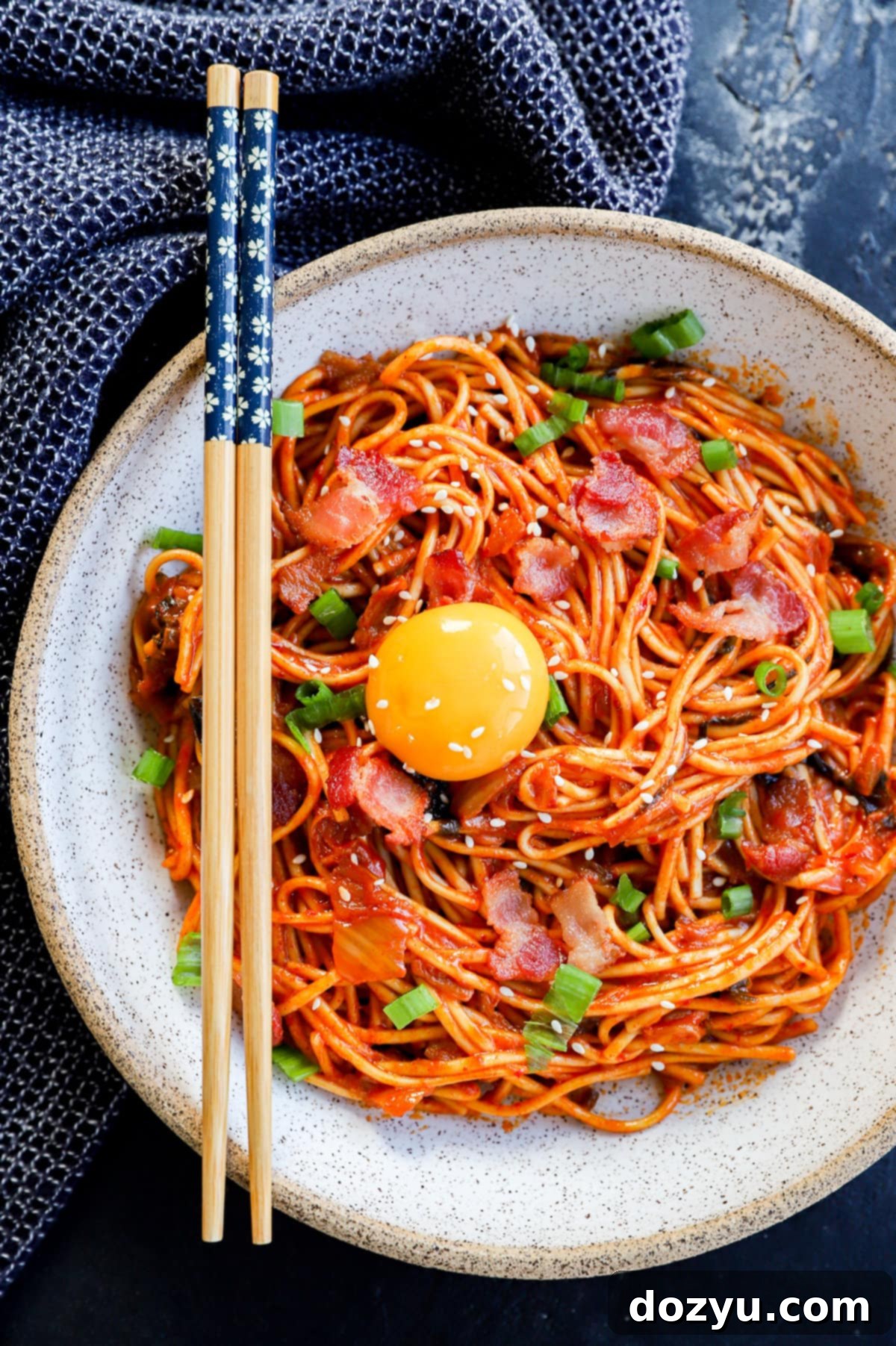Easy Creamy Kimchi Udon: Your Go-To 20-Minute Weeknight Noodle Masterpiece
Get ready to elevate your weeknight dinner game with this incredibly easy and incredibly flavorful Creamy Kimchi Udon. In just 20 minutes, you can whip up a bowl of these satisfyingly chewy udon noodles, coated in a rich, spicy, and tangy sauce, punctuated by crispy bacon and the unmistakable zing of kimchi. It’s a dish that promises a big pop of flavor and is destined to become your new favorite go-to meal for those busy evenings. If you crave bold tastes and comforting noodles, this recipe is an absolute must-try!
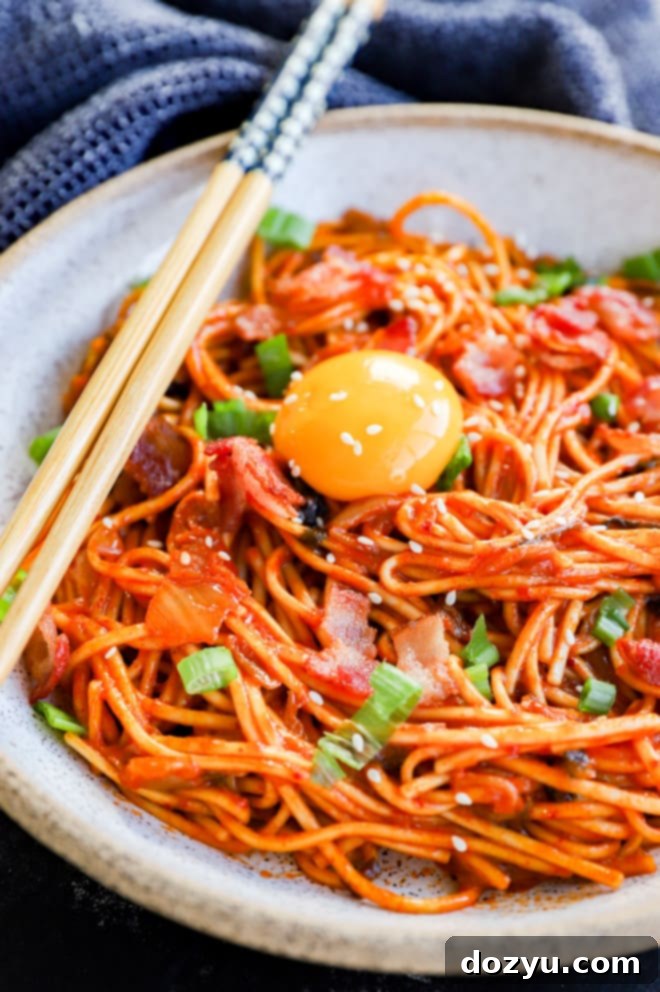
table of contents
Toggle
About This Kimchi Udon Recipe
Who doesn’t adore a simple noodle dish bursting with incredible flavor? I certainly do! While many cuisines offer fantastic quick noodle recipes, today our focus is squarely on a Korean-inspired masterpiece: a creamy and spicy Kimchi Udon. We’re diving deep into the vibrant world of Korean ingredients – tangy kimchi, savory gochujang, aromatic sesame seeds, and more – to create an unforgettable meal that comes together in mere minutes.
My love affair with kimchi runs deep. Its unique combination of fermented tang and fiery heat makes it an exceptional condiment, but it’s so much more than that; for many, including myself, it’s truly a lifestyle. This fermented cabbage not only brings a profound depth of flavor but also a bold kick that awakens the taste buds, making it the perfect companion for those thick, wonderfully chewy udon noodles.
If you’re like me, constantly seeking a meal that’s not only quick and delicious but also boasts a certain “wow” factor, then this creamy kimchi udon recipe is precisely what you need. It’s gloriously spicy, delightfully creamy, and remarkably, it’s ready in just 20 minutes, all cooked in a single skillet. The magic lies in the way the kimchi caramelizes with the gochujang, forming a rich, complex sauce that coats every strand of udon.
One of the best aspects of this easy udon recipe is its versatility. You can effortlessly customize it to suit your preferences by incorporating your favorite protein – think tender chicken, succulent steak, savory pork, or plump shrimp. For an added nutritional boost and texture, feel free to toss in some fresh vegetables like zucchini, arugula, or spinach. With a total preparation and cooking time of just 20 minutes, enjoying a restaurant-quality Korean noodle dish at home has never been easier or more accessible.
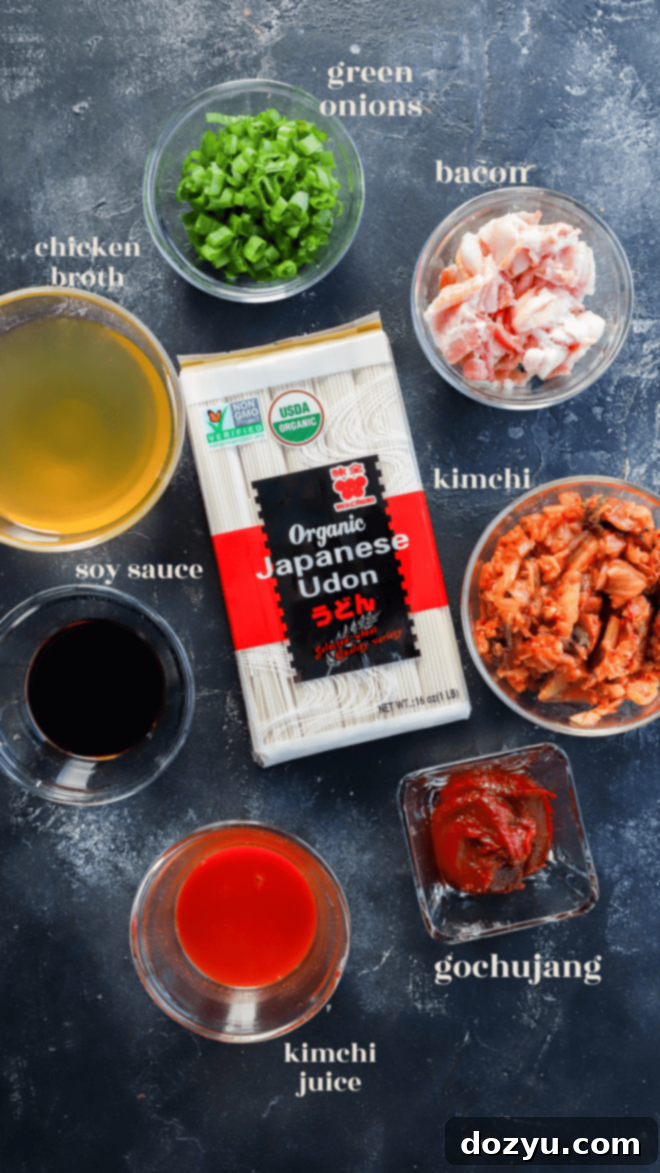
Ingredients Overview
Crafting the perfect creamy kimchi udon relies on a few key ingredients, each playing a crucial role in developing its signature bold and comforting flavor profile. Here’s a closer look at what you’ll need:
- Bacon: For this recipe, I highly recommend using thick-cut bacon. Its rendered fat provides an incredible base of savory flavor for the sauce, and the crispy bits add a delightful textural contrast to the soft noodles. However, any type of bacon you prefer will work beautifully to impart that essential smoky, salty note.
- Udon Noodles: The star of our dish! Udon noodles are cherished for their thick, chewy texture, which is perfect for soaking up the rich kimchi sauce. You can use fresh, frozen, or even dried udon noodles. Fresh and frozen varieties tend to have a superior, chewier consistency, often found in the refrigerated or frozen sections of Asian markets or larger grocery stores. Dried udon is a convenient pantry staple.
- Kimchi: The heart and soul of this Korean noodle dish. Choose your favorite brand of fermented napa cabbage kimchi. Its distinct tangy, spicy, and umami-rich flavor is irreplaceable. Good quality kimchi is typically available at your local grocery store or any Asian marketplace.
- Kimchi Juice: Don’t discard that precious liquid at the bottom of your kimchi jar! It’s a goldmine of concentrated kimchi flavor and acidity, crucial for deepening the tang and spice in our sauce.
- Gochujang (Korean Red Chili Paste): A fundamental Korean ingredient that brings a harmonious blend of savory, sweet, and spicy notes. This thick, vibrant red paste is not just about heat; it helps caramelize the kimchi, adding a beautiful depth and gloss to the sauce.
- Broth (Chicken or Vegetable): This forms the liquid base of our creamy sauce. Chicken broth offers a richer, more savory undertone, while vegetable broth keeps the dish vegetarian-friendly without sacrificing flavor. Choose what best suits your dietary needs and taste preferences.
- Soy Sauce: Essential for umami and seasoning. I generally opt for low-sodium soy sauce to control the overall saltiness of the dish, allowing us to adjust it to taste at the end.
- Butter (Unsalted): This is the secret to achieving that luscious, creamy texture in our udon. Unsalted butter gives you more control over the seasoning. If using salted butter, simply be mindful when adding extra salt later.
- Scallions (Green Onions): Freshly chopped scallions are used as a vibrant garnish, providing a fresh, slightly pungent “zing” and a pop of color that brightens the rich flavors of the noodles.
- Egg Yolks: The magic ingredient for ultimate creaminess! A raw egg yolk (or a soft, runny sunny-side-up egg) stirred into the hot noodles creates an incredibly decadent, silky sauce that truly elevates this dish to a gourmet level.
Essential Kitchen Tools
One of the many joys of this 20-minute kimchi udon recipe is how few tools you actually need. Simplicity is key for a quick weeknight meal! To get started with prepping your ingredients, you’ll want to grab your favorite sharp chef’s knife and a sturdy cutting board for chopping the bacon and kimchi with ease.
The beauty of this dish truly shines in its one-skillet approach. You will only need one large skillet to cook this entire meal from start to finish. I personally love using a cast iron skillet for its excellent heat retention and even cooking, which helps achieve that perfect caramelization of the kimchi. If you’re looking for a reliable and budget-friendly option, a Lodge cast iron skillet is an excellent choice. However, any large skillet with high sides will work well, providing ample space to toss the noodles and ensure all those delicious flavors meld together perfectly.
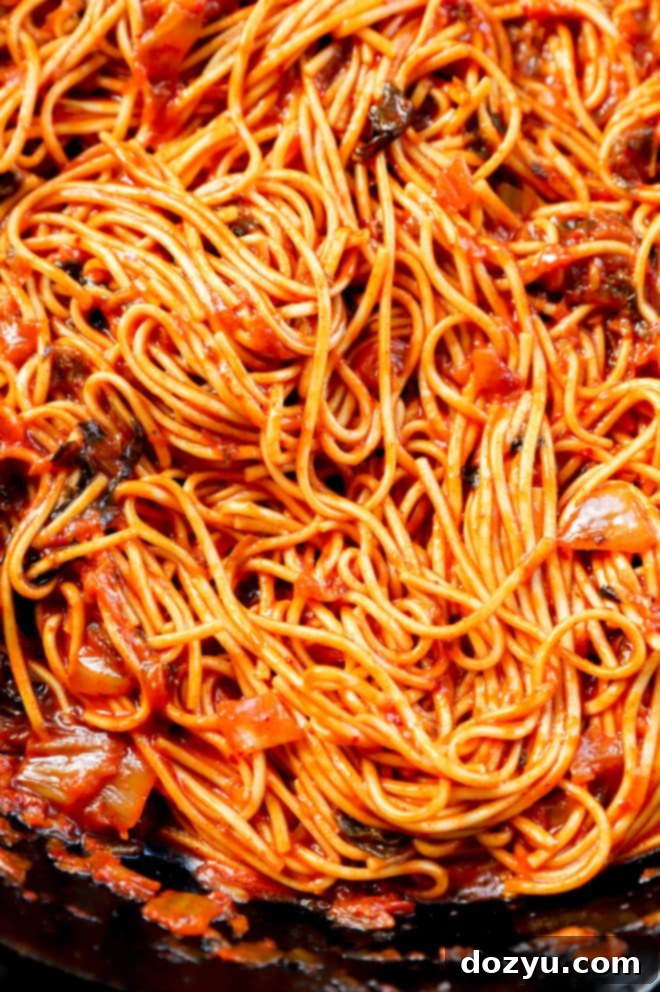
Here’s How to Make Kimchi Udon
Creating this flavorful and creamy kimchi udon is incredibly straightforward. Follow these simple steps for a delicious meal in under 20 minutes:
1. Cook Bacon for Flavor and Texture
Begin by finely chopping your bacon. In a large skillet – preferably a cast iron one for optimal results – cook the chopped bacon over medium-high heat. Allow it to render its fat and crisp up beautifully, which usually takes about 3 to 4 minutes. Once perfectly crispy, remove the bacon pieces from the skillet and transfer them to a plate lined with a paper towel to drain any excess grease. This will keep them wonderfully crunchy. Make sure to reserve about 1 tablespoon of that flavorful bacon fat in the pan; this will be the foundation of our sauce. Discard or save any remaining bacon fat for another use.
2. Craft the Creamy Kimchi Sauce
Return the skillet, with the reserved bacon fat, to medium-high heat. Add your chopped kimchi and the gochujang paste to the hot fat. Cook this mixture, stirring occasionally, for about 4 minutes. During this time, the kimchi will soften and begin to caramelize, developing a deeper, sweeter, and more complex flavor. The gochujang will also toast slightly, enhancing its savory and spicy notes. Next, stir in the broth (chicken or vegetable), kimchi juice, and soy sauce. Bring this mixture to a gentle simmer and let it cook for another 4 to 5 minutes, allowing the liquid to slightly reduce and the flavors to meld into a rich, thick, and perfectly balanced sauce.
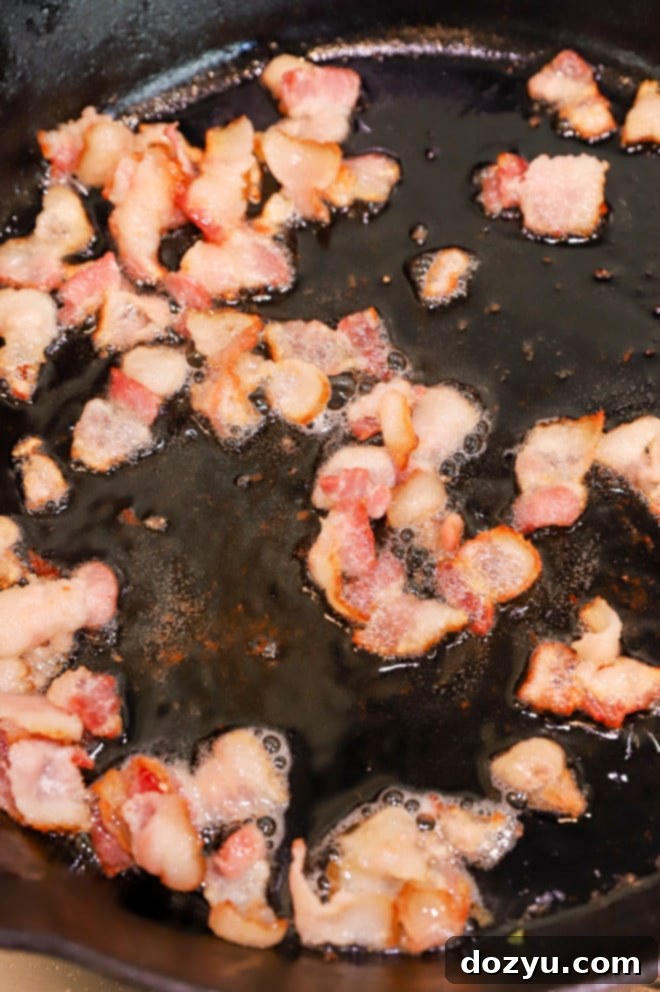
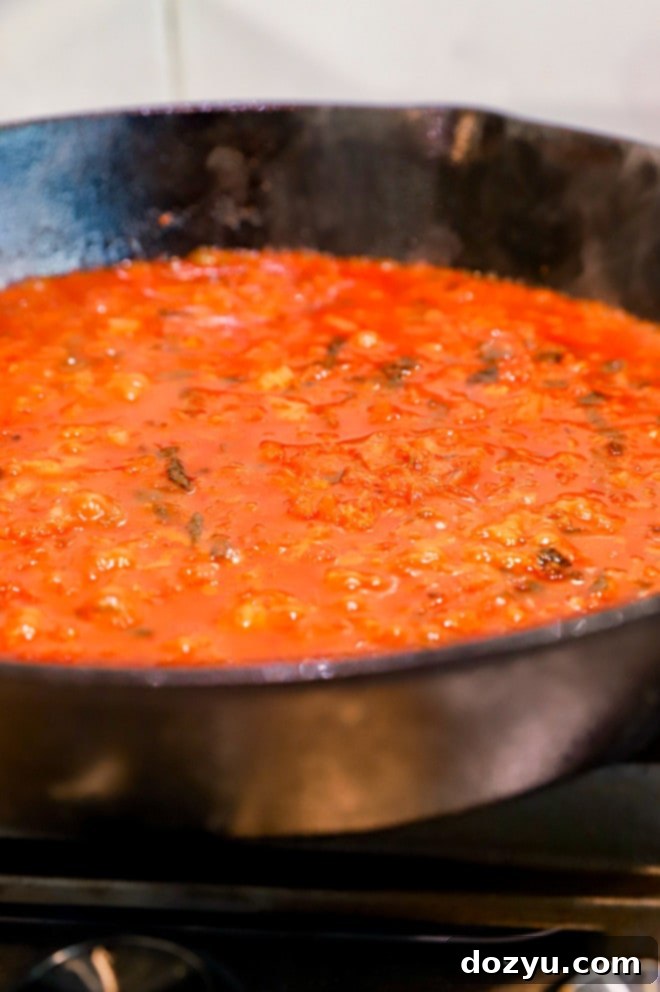
3. Prepare the Udon Noodles
While your sauce is simmering and developing its incredible flavor, prepare your udon noodles. It’s crucial to follow the package directions precisely, as cooking times can vary significantly between fresh, frozen, and dried udon. Typically, fresh udon requires just a minute or two in boiling water, frozen udon a few minutes longer, and dried udon might need a full boil and simmer. The goal is perfectly al dente noodles that are chewy, not mushy.
4. Combine and Finish Your Dish
Once your udon noodles are cooked, drain them thoroughly. Add the drained noodles directly to the spicy, aromatic sauce in the skillet, along with the unsalted butter. Toss everything together vigorously, ensuring every thick, chewy udon noodle is beautifully coated in the creamy, rich sauce. Cook for about 2 minutes, allowing the butter to melt and the noodles to fully absorb the flavors. Now, stir in most of your crispy bacon, reserving a small amount for garnish. Taste the noodles and season with salt and freshly ground black pepper as desired. Remember to be cautious with salt, especially if your kimchi or soy sauce is already quite salty.
Finally, transfer the creamy kimchi udon to individual bowls. Top each serving with the reserved crunchy bacon, a generous sprinkle of freshly chopped green onions (scallions), a dash of sesame seeds for nutty flavor, and, for the ultimate creamy indulgence, a raw egg yolk per serving. The warmth of the noodles will gently cook the yolk, transforming the sauce into an even silkier, richer experience.
Pro Tips and Tricks for Kimchi Udon
To truly master this creamy kimchi udon recipe and make it your own, consider these additional tips and tricks:
- Add More Protein: If you’re looking to turn this flavorful side into a heartier main course, adding protein is simple and highly recommended. Incorporate cooked, shredded chicken, thinly sliced steak, or chopped pork alongside the bacon when you toss the noodles into the sauce. For a quicker option, quickly seared shrimp can be added at the very end to prevent overcooking. Tofu or tempeh also work wonderfully for a plant-based protein boost.
- Embrace the Egg Yolk: The raw egg yolk on top isn’t just for show – it’s a game-changer! As you stir it into the warm noodles, it creates an unparalleled creaminess and richness, truly making this dish “creamy kimchi udon.” If raw egg isn’t your preference, a perfectly runny sunny-side-up egg or a softly fried egg achieves a similar decadent effect.
- Incorporate More Vegetables: This is an ideal canvas for adding your favorite veggies. Sautéed mushrooms, sliced bell peppers, spinach, or arugula can be stirred in during the last minute of cooking the sauce or just before serving. This not only adds nutrition and color but also makes the meal more substantial. Broccoli florets or zucchini ribbons would also be excellent additions.
- Storage and Reheating: Leftover kimchi udon can be stored in an airtight container in the refrigerator for up to 2-3 days. When reheating, a microwave or a skillet over medium heat works best. You might want to add a splash of broth or water to loosen the sauce as it can thicken in the fridge. Note that the noodles might lose some of their chewiness upon reheating, but the flavors will still be delicious.
- Adjust Spice Levels: While this is meant to be a spicy dish, you can slightly adjust the heat. See the FAQ section below for detailed advice on how to make it less spicy without compromising too much on flavor.
More tasty noodle recipes: Curry Udon | Pasta Napolitana | Gochujang Noodles | Roasted Lemon Garlic Shrimp Pasta
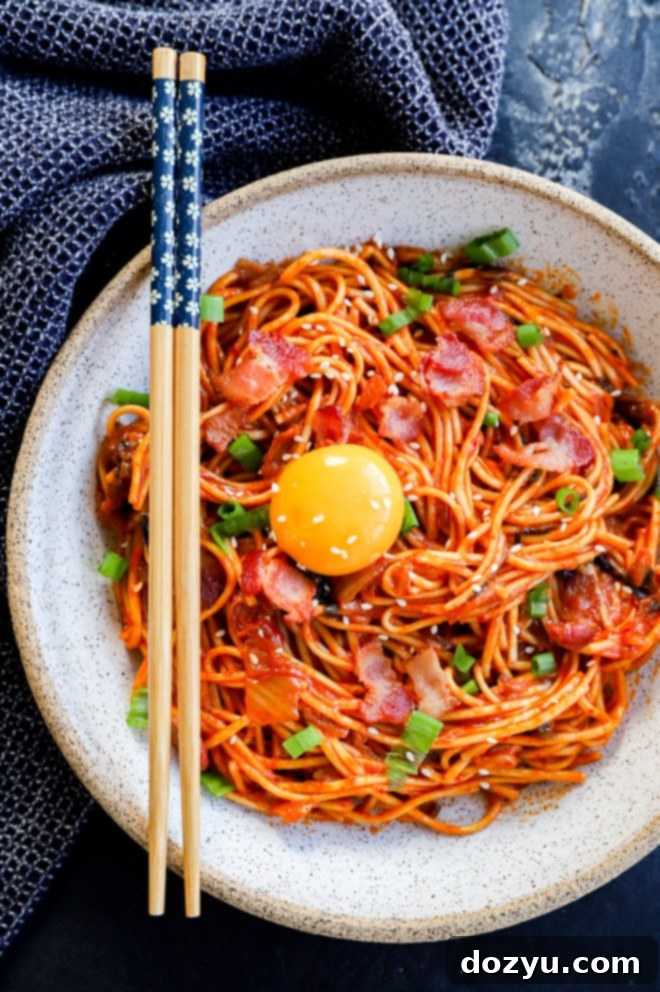
Kimchi Udon Spice Level: Is It Really Hot?
Yes, this kimchi udon is intentionally designed to be a delightfully spicy dish! The heat primarily comes from two key ingredients: the kimchi itself and the gochujang (Korean red chili paste). Kimchi, being a fermented food, naturally has a pungent and spicy kick that varies depending on the brand and its fermentation level. Gochujang then layers on a robust, sweet, and savory heat that is distinctly Korean.
This combination creates a bold, fiery flavor profile that is incredibly satisfying and wakes up your palate. If you’re a fan of spicy food, you’ll absolutely love the intense flavor punch. If you’re sensitive to heat, please refer to our “Making Kimchi Udon Less Spicy” section for tips on how to temper it slightly, though it will inherently retain some level of spice due to its core ingredients.
Choosing the Best Udon Noodles for Your Dish
The type of udon noodles you choose can significantly impact the texture of your final dish. Fortunately, almost any kind of udon will work, but here’s a breakdown to help you pick the best for your kimchi udon recipe:
- Fresh Udon Noodles: These are often found in the refrigerated section of Asian grocery stores. They typically offer the most authentic chewy, bouncy texture. They cook very quickly, sometimes in just a minute or two.
- Frozen Udon Noodles: My personal preference and often the easiest to find with great quality! Frozen udon noodles usually come in individual vacuum-sealed packets and boast an excellent, wonderfully chewy texture that rivals fresh udon. They cook up perfectly straight from the freezer in boiling water in just a few minutes, making them incredibly convenient for a 20-minute meal.
- Dried Udon Noodles: These are a pantry staple and are widely available in most grocery stores. While good, they can sometimes be thinner and slightly less chewy than fresh or frozen varieties. If using dried, ensure you follow the package instructions carefully to avoid overcooking and achieving the best possible texture.
Regardless of the type you choose, the most important step is to prepare your udon noodles according to the package instructions *before* adding them to the sauce. This might involve boiling them for a few minutes or simply soaking them in hot water, depending on the specific product. Ensure they are drained well before combining them with the flavorful kimchi sauce.
How to Add More Protein to This Kimchi Udon Recipe
Absolutely! This creamy kimchi udon is incredibly versatile and lends itself beautifully to adding extra protein, transforming it into an even more substantial and satisfying meal. Here are some fantastic options:
- Chicken: Cooked shredded chicken or cubed chicken breast can be easily incorporated. You can stir it in with the bacon and noodles at the end, or if you prefer, sear chicken pieces in the skillet before adding the kimchi to infuse more flavor.
- Steak: Thinly sliced beef (like sirloin or ribeye) can be quickly seared in the skillet after the bacon is removed, then set aside and added back with the noodles. This adds a rich, meaty depth to the dish.
- Pork: Leftover cooked pork, whether shredded or diced, is another excellent addition. Alternatively, you can sear thinly sliced pork belly or pork shoulder pieces until crispy before starting the sauce.
- Shrimp: For a quick seafood option, add raw shrimp to the skillet a few minutes before the noodles are fully coated. Shrimp cooks very quickly, turning pink when done, and adds a lovely sweetness to the spicy sauce.
- Tofu or Tempeh: For a vegetarian or vegan option, pan-fried or air-fried cubes of extra-firm tofu or tempeh can be added with the noodles. Ensure they are pressed and cooked until golden brown for the best texture.
Don’t forget to think about vegetables too! Adding sautéed mushrooms, bell peppers, or even a handful of fresh spinach or arugula at the very end can make this udon noodle dish feel more like a complete kimchi udon stir fry, packed with nutrients and varying textures.
Making Kimchi Udon Less Spicy
Since kimchi is inherently spicy and forms the core flavor of this dish, it can be a bit challenging to significantly tone down the heat without altering the overall taste profile. However, if you are particularly sensitive to spice but still want to enjoy the deliciousness of creamy kimchi udon, here are a couple of approaches:
- Reduce Gochujang: The gochujang is a major contributor to the heat. You can try reducing the amount of gochujang paste from 2 tablespoons to 1 tablespoon, or even half a tablespoon, depending on your tolerance. Be aware that this will also slightly lessen the rich, sweet-savory notes it provides.
- Omit Kimchi Juice and Add More Broth: The kimchi juice adds an extra layer of concentrated spice and tang. You could omit it entirely and replace that liquid volume with additional chicken or vegetable broth. This will dilute the spiciness somewhat, though it may also make the overall flavor a bit less intense and tangy.
- Add Dairy: Incorporating a little more dairy can help temper the heat. A tablespoon or two of heavy cream or a dollop of sour cream stirred into the sauce at the end can add richness and mellow the spice. This leans into the “creamy” aspect even more!
- Choose Milder Kimchi: Some brands of kimchi are less spicy than others. If you have the option, look for a milder variety. Also, less fermented, younger kimchi tends to be less spicy than very mature kimchi.
Even with these adjustments, the dish will still carry some heat due to the presence of kimchi. The goal is to find a balance that suits your personal preference while still retaining the distinctive flavors that make this spicy udon noodle recipe so delicious.
Need some inspiration for dinners this week? Check out my main dish recipe page!
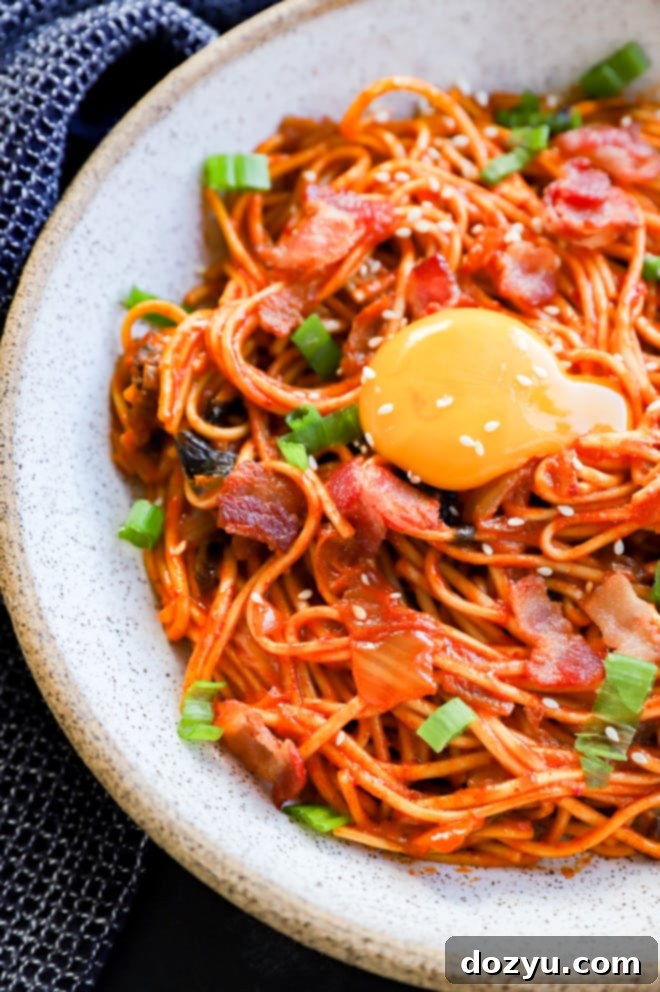
What to Serve with Kimchi Udon for a Complete Meal
This creamy kimchi udon is so robust and complete on its own that it truly functions as a one-skillet meal. However, a few thoughtful additions can elevate the experience even further:
- The Essential Egg Topping: My absolute favorite way to serve kimchi udon is topped with a raw egg yolk! The runny yolk, when stirred into the hot noodles, creates an incredibly luscious and creamy texture that takes the dish to another level of indulgence. If a raw yolk isn’t for you, a perfectly cooked sunny-side-up egg or a fried egg with a gloriously runny yolk achieves a similar effect, adding richness and a delightful protein boost.
- Fresh Greens for Balance: To add a touch of freshness, nutrition, and a slight bitterness to cut through the richness, consider incorporating fresh greens. A handful of fresh arugula or spinach stirred in at the very end of cooking, just before serving, will wilt beautifully and add a vibrant contrast. This also helps bulk up the dish, making it even heartier.
- Extra Garnishes for Flair: Beyond the crispy bacon and fresh scallions already mentioned, a sprinkle of toasted sesame seeds adds a nutty aroma and delicate crunch. A drizzle of sesame oil just before serving can also enhance the overall fragrance.
- Spice It Up (or Down) to Taste: For those who truly love the heat, serving extra chopped kimchi on the side allows individuals to customize their spice level. Similarly, offer extra crispy bacon pieces and freshly sliced green onions for those who want more crunch and freshness.
- Light Side Dishes (Optional): While not strictly necessary, if you desire a fuller Korean-inspired spread, a simple side of steamed white rice can help soak up any extra sauce. A light, refreshing cucumber salad or a simple banchan (Korean side dish) like seasoned bean sprouts would also complement the bold flavors of the udon without overpowering it.
Remember, the beauty of this easy udon noodle recipe is its inherent completeness. Feel free to enjoy it as is, or dress it up with these simple additions for a truly memorable meal!
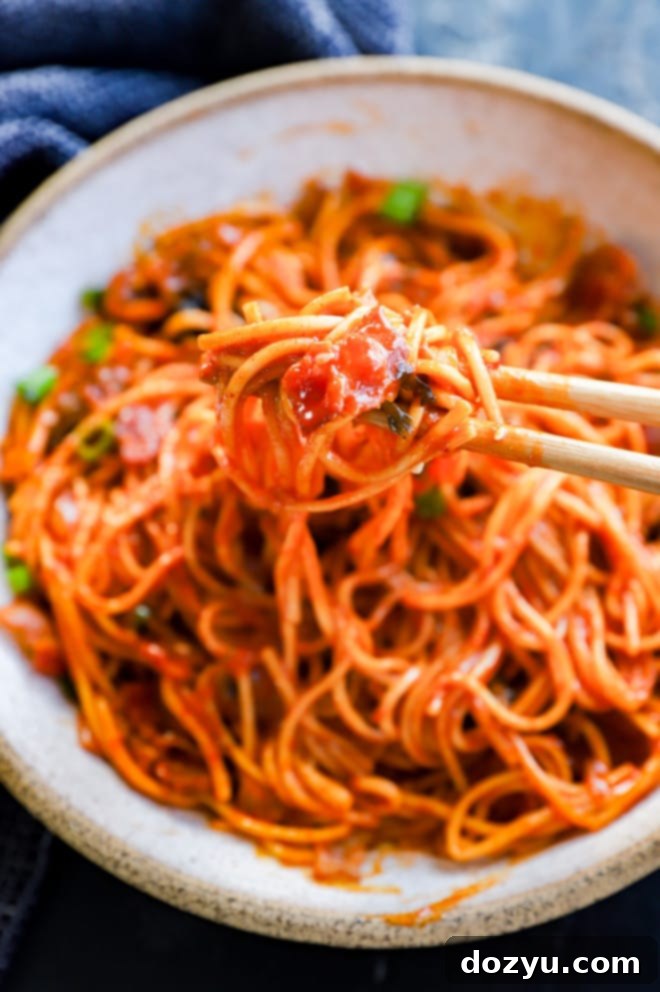
More Quick and Easy Dinner Recipes to Try
If you loved the speed and flavor of this creamy kimchi udon, you’ll definitely want to explore these other fantastic quick and easy dinner recipes:
- For a taste of Mediterranean sunshine, our Lemon Ricotta Pasta with fresh arugula is another delightful dish that comes together in just 20 minutes, offering a bright and creamy alternative.
- Craving something sweet and savory with a tropical flair? Try this vibrant Mango Chicken Salad. It’s incredibly versatile and can be served traditionally as a sandwich or as a refreshing lettuce wrap.
- Whip out your air fryer for this elegant yet simple Air Fryer Scallops recipe! Served with a delicate chive lemon butter, these perfectly cooked scallops are a fantastic, quick protein that pairs wonderfully with a side of pasta or a light salad.
- If you’re still on a Korean-inspired kick, these Gochujang Noodles with Chicken and Greens offer a different take on spicy, savory noodles, showcasing the versatility of gochujang.
Finally, if you do make this kimchi udon recipe, please be sure to give this recipe a star rating on the recipe card below and/or leave a comment! I absolutely adore hearing about your culinary adventures and take the time to respond to every single comment. Your feedback is invaluable!
Feel free to drop any questions below as well, if you have them. I’m always happy to help!
Oh, and be sure to tag me on Instagram if you share your creation! Seeing these recipes come to life in your homes is truly my favorite thing, and I love looking through all those wonderful photos. It genuinely means the world to me!
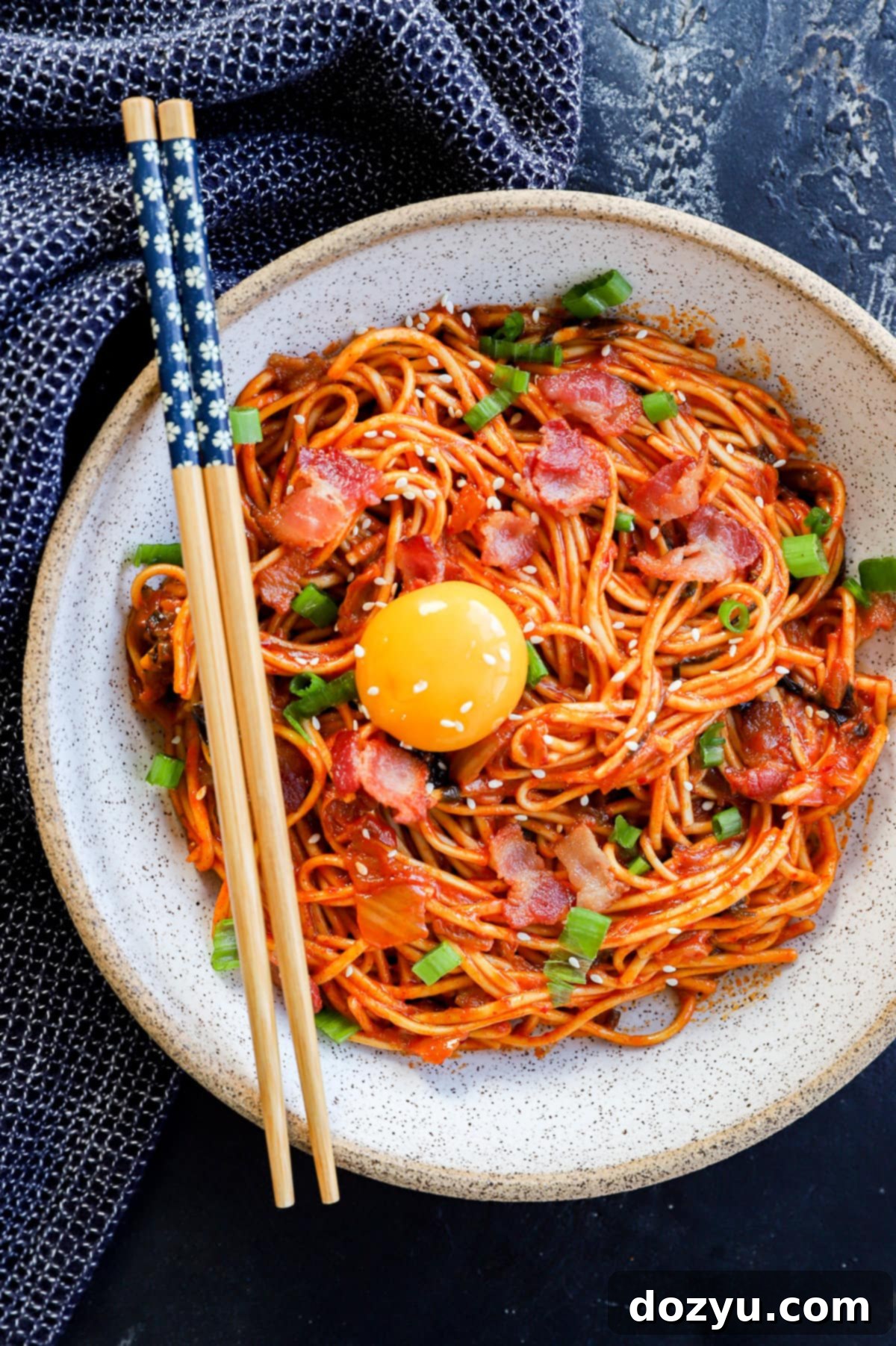
Kimchi Udon
Ingredients
- 4 slices bacon roughly chopped
- 1 lb fresh or frozen udon noodles
- 1 cup of chopped Kimchi
- 1/3 cup kimchi juice
- 2 Tbsp gochujang paste
- 1/2 cup chicken or vegetable broth
- 2 Tbsp soy sauce
- 3 Tbsp unsalted butter
- optional: room temp egg yolks
- garnish: freshly chopped green onion, sesame seeds
Instructions
-
In a large skillet over medium-high heat, cook chopped bacon until crispy. Remove bacon to a paper towel-lined plate and reserve for later. Reserve 1 Tbsp bacon fat in the pan and discard the rest.
-
Return skillet to medium-high heat and add kimchi and gochujang. Cook, stirring occasionally, until the kimchi is lightly caramelized, about 4 minutes. Stir in broth, kimchi juice, and soy sauce. Bring the mixture to a simmer, cooking until thickened and slightly reduced. This will take about 3 to 5 minutes.
-
While the sauce is cooking, cook the noodles according to the directions on the package.
-
Drain the noodles, then add to the sauce with butter. Toss to coat, then stir in cooked bacon, reserving some for garnish. Taste and season with salt and pepper as desired.
-
Divide among bowls. Top with egg yolks, scallions, crispy bacon, and sesame seeds.
Video
Nutrition
